The Isenheim Altarpiece
After over 4 years of work, the major restoration project has been completed in Colmar
Visit the Musée Unterlinden to discover the newly uncovered brilliance of this legendary artwork
The Isenheim Altarpiece, the monumental polyptych created between 1512 and 1516 by the painter Grünewald and the sculptor Niclaus of Haguenau, is the masterpiece of the collection at Colmar’s Musée Unterlinden. Having been regularly maintained and revarnished since the 18th century, it underwent an exceptional full restoration project beginning in 2018 (covering everything from the painted panels and sculptures to the frames and more), with visitors able to observe the completion of the process in late June 2022.
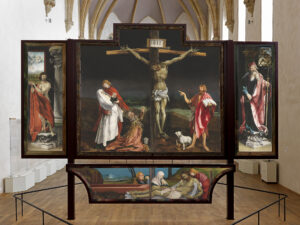
A look back at four and a half years of restoration carried out by two teams across three sites
Following the 2003 report on the condition of the painted panels and the symposium devoted to Grünewald’s technique in 2006, it was observed that the Altarpiece was suffering from a severe accumulation of dirt, whilst the painted panels had grown significantly darker and more opaque due to the numerous layers of oxidised varnish, undermining coherence across the artwork as a whole. As part of a general restoration plan for the Musée Unterlinden’s artworks, linked to its extension and refurbishment, the regional restoration committee approved the beginning of the restoration of the altarpiece’s painted panels in 2011. In 2013, the museum commissioned a new study in order to draw up specifications for a full restoration of the different components of the altarpiece: the painted panels and their frames, the sculptures and the caisse, the wooden structure containing them, which dates from 1930.
Under the aegis of the scientific committee composed of museum professionals, restorers and art historians from France, Germany and Switzerland, two teams were selected in late 2017 and the vast restoration programme was launched across three sites in autumn 2018.
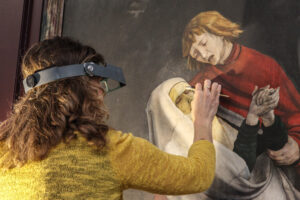
The team of paintings restorers led by Anthony Pontabry took care of the restoration of the painted panels and the original frames within the chapel of the Musée Unterlinden, directly observed by the public. Restoring the altarpiece in public view was a decision taken out of a desire for transparency, a genuine conservation concern (avoiding the need to move the panels) and also in order not to disappoint visitors to the museum who had come to admire the altarpiece.
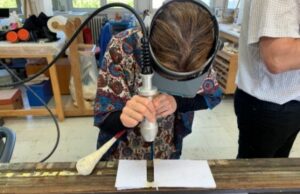
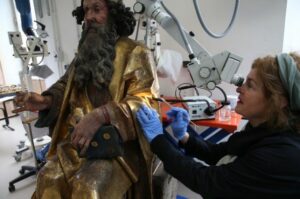
Only the detachable frames of certain panels (St Sebastian, St Anthony and the predella) were restored in Vesoul, at the Regional Workshop for Artwork Restoration and Conservation.
The sculptures, which required a space specifically suited to the work to be undertaken, were restored in the polychrome wood restoration workshop operated by the Musées de France Centre for Research and Restoration (C2RMF) in Paris, by the sculpture restoration team led by Juliette Lévy.
In late June 2022, after over four years of restoration, as well as the conservation measures and the newly uncovered brilliance of the work, the public could admire the original coherence between the painted panels and the sculptures, particularly in terms of their colours. Comparative analysis of the pigments used for the sculptures and panels proved that Grünewald’s workshop did indeed apply the colour to the sculptures created by Niclaus of Haguenau. The restored painted panels reveal the chromatic range of the artist’s palette, the vividness of the colours and the depth of field. Visitors who take the time to observe the altarpiece carefully will be able to discover surprising new details previously concealed by the varnish or by retouching: a dense black sky now midnight blue, striped with grey and black clouds, new contours to the long hair down Mary Magdalene’s back, a tear that can be made out on the Virgin Mary’s cheek, the recaptured subtlety of the sculptures’ flesh tones… all good reasons to visit Colmar to (re)discover this masterpiece and its rejuvenation.
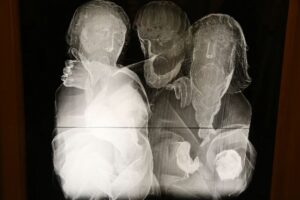
The Musée Unterlinden, Colmar
The Musée Unterlinden officially opened on 3 April 1853. As well as the 3rd-century mosaic discovered in Bergheim in 1848 and the plaster casts of ancient sculptures, the erudite local audience was able to admire artworks such as the Isenheim Altarpiece and Martin Schongauer’s Altarpiece of the Dominicans that had been confiscated during the French Revolution. Nowadays, the Musée Unterlinden is a place of discovery offering its numerous visitors dialogue and knowledge, pleasure and emotions. They can explore a permanent collection covering nearly 7,000 years of history, from Prehistoric times to 20th-century art.
In parallel to this journey through time within its collections covering the fine arts, history and society, visitors can also discover the multiple facets of the museum’s architecture, which were unified and enhanced by the refurbishment and extension project undertaken by the architects Herzog & de Meuron, completed in late 2015. Exploring the rooms of the 13th-century former convent, the old Municipal Baths inaugurated in 1906 and the contemporary spaces built in 2015 alongside the collections, visitors can admire the successive stages of over 150 years of the museum’s history. The walls and the artworks bear witness to the dynamic work of the Société Schongauer, the charitable association that has run the Musée Unterlinden since 1853.